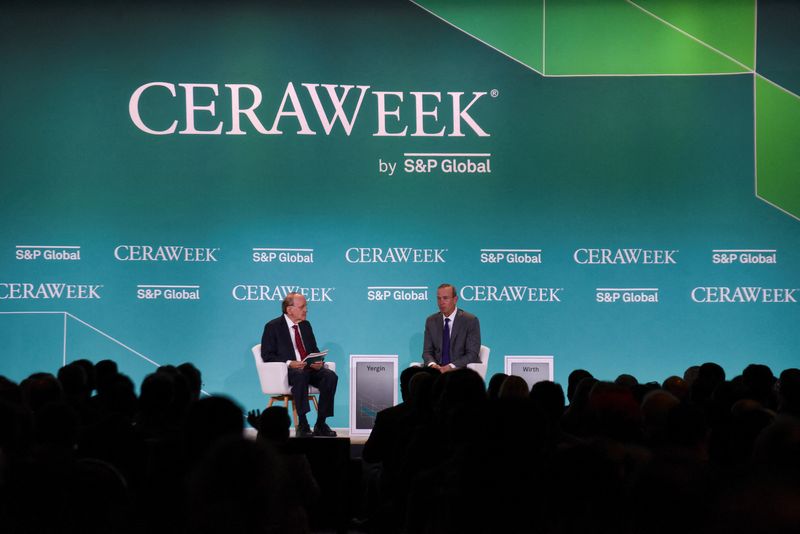Commodities
Oil mergers, clean fuels vie for attention at Houston energy conference


© Reuters. FILE PHOTO: Mike Wirth, the CEO of Chevron Corporation, speaks with Daniel Yergin, the vice chairman of S&P Global, as top energy executives and officials from around the world gather during the CERAWeek 2023 by S&P Global, energy conference in Houston, T
By Arathy Somasekhar
HOUSTON (Reuters) -Top oil executives and ministers descend on Houston this week for one of the world’s biggest energy conferences emboldened by blockbuster mergers, stable oil prices and less pressure for a large-scale move to clean fuels.
Global oil prices have remained in a range between $75 and $85 per barrel, a level fueling profits but not hurting economic growth, despite war in Eastern Europe and turmoil in the Middle East. Stock markets continue to spur deals, making Big Oil even bigger.
The annual CERAWeek conference comes as demand for oil and gas continues to rise alongside solar, wind and biofuels. Energy markets have accommodated a reordering of global flows as customers turn more to regional energy suppliers or live with longer seaborne supply chains.
“A remarkable thing is the (price) stability, given the geopolitical turmoil,” said Daniel Yergin, vice chairman of conference organizer S&P Global and a Pulitzer Prize-winning author on global energy.
Unlike past conferences where conversations were dominated by market-share battles between U.S. shale oil producers and the Organization of the Petroleum Exporting Countries, talk of price wars have been supplanted by energy security issues, Yergin said.
“When demand was down and prices were down, it was very easy to see a way towards energy transition, but with Russia/Ukraine (war) and price shocks, energy security is back on the table,” Yergin added.
More than 7,200 people are expected to hear the latest outlook on energy markets from the heads of top producers’ BP (NYSE:), Chevron (NYSE:), Exxon Mobil (NYSE:), Saudi Aramco (TADAWUL:), Sinopec (OTC:) and Petronas.
Global liquefied (LNG) developments and U.S. climate policies will be a major topic in separate sessions by big exporters Cheniere Energy (NYSE:) and Venture Global LNG, while U.S. Energy Secretary Jennifer Granholm and White House adviser John Podesta press the administration’s climate goals.
While oil prices are strong, natural gas has been overwhelmed by a production glut. But “this year will be a transition year to a much more bullish gas and power market next year,” said Vikas Dwivedi, an energy strategist at financial firm Macquarie Group (OTC:).
Notably absent this year, which occurs during the Islamic holy month of Ramadan, are top oil ministers from Saudi Arabia, Kuwait and Iraq. No officials from Russia are expected after they did not attend last year.
OPEC’s absence comes with global prices hovering around $85 a barrel, a level that Dwivedi said helps cover its members’ budgets, but does not accelerate transition to electric vehicles and renewable fuels.
OPEC forecasts relatively strong oil demand and economic growth, a view that encourages more oil and gas activity and mergers. Last year’s more than $250 billion in U.S. energy deals stirred fears of concentration and a slowing of regulatory approvals.
Climate concerns are reflected in the conference sessions on carbon sequestration technology and hydrogen fuels, which have become two of the oil industry’s favorite means of addressing global warming. The role of artificial intelligence in energy production and carbon emissions are prominent sessions this year.
Energy consumers’ willingness to pay up for clean fuels or for new technologies to address emissions “is a growing issue, as is the ability to generate adequate return on investment” by energy companies, said Joe Scalise, consultancy Bain & Co’s head of energy and natural resources.
A constant topic at the CERAWeek conference in the last decade has been the ups and downs of U.S. shale, which revolutionized energy markets and turned the United States into the world’s No. 1 crude producer and a top exporter.
This year, acquisitions by Chevron, ConocoPhillips (NYSE:) and Exxon Mobil will turn the trio into the largest producers in the top U.S. shale field. That shift promises to tame what was a wild card in global oil production. Big Oil’s investments and production methods may steady shale’s ultra boom-bust cycles.
Commodities
Oil prices rise; U.S. crude inventories plunge, Russia-Ukraine truce eyed
Commodities
India’s Reliance to stop buying Venezuelan oil over US tariffs, sources say
Commodities
Oil prices climb on Venezuela supply worries

 Forex3 years ago
Forex3 years agoForex Today: the dollar is gaining strength amid gloomy sentiment at the start of the Fed’s week

 Forex3 years ago
Forex3 years agoUnbiased review of Pocket Option broker

 Forex3 years ago
Forex3 years agoDollar to pound sterling exchange rate today: Pound plummeted to its lowest since 1985

 Forex3 years ago
Forex3 years agoHow is the Australian dollar doing today?

 Cryptocurrency3 years ago
Cryptocurrency3 years agoWhat happened in the crypto market – current events today

 World3 years ago
World3 years agoWhy are modern video games an art form?

 Commodities3 years ago
Commodities3 years agoCopper continues to fall in price on expectations of lower demand in China

 Economy3 years ago
Economy3 years agoCrude oil tankers double in price due to EU anti-Russian sanctions

























